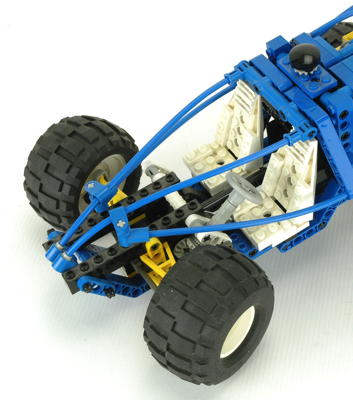Features
|
|
Steering
The front wheels can be steered using a "hand of god"wheel at the
top
of the vehicle. The wheel drives through a set of bevel
gears. While most vehicles have rack and pinion steering, this
model uses an engine crank pin to translate a small flex axle back and
forth. The flex axle acts as a tie rod. The rarely used steering
hubs and ball joints support the wheels.
The driver's steering wheel is geared into the system and is therefore functional.
|


Click for an animation of the steering in motion.
|
|
Doors
The doors use the simplest mechanism possible, pivoting around connectors on the body flex tubes. |

Click for an animation of the doors in motion. |
|
Engine
The model has a rear mounted V-4 engine with transparent
cylinders. The entire engine can be easily removed by simply
raising the rear hatch and pulling it out. The hatch locks the
engine in place when down. The ease of engine maintenance would be
useful on the way to Dakar.
Since the engine sits above the suspension but is connected the rear
wheels, the drive system must pass across the suspension axis.
Driving an axle also used for suspension is a problem because of the
weight on the axle, and this model solves that problem by using clutch
gears which can slip on their axles. Consequently, it works very
smoothly.
A differential completes the gear train. The ratio between the wheels and the engine is 3:1.
|
 
 
Click for an animation of the engine in motion. |
|
Differential
The rear axle is "live" and uses a differential
gear which incorporates a built in 16 and 24 tooth ring gear. The
differential is made
to house 3 of the 12 tooth bevel gears. One is on each axle,
and one planet gear in the middle allows the axles to turn at different
rates.
This model uses the smaller 16 tooth ring gear of the diff, one of the only models to make use of it.
|
 
Click for an animation of the differential in motion. |
|
Suspension
The rear trailing axle has a large travel using angled shock
absorbers. Since the front has no suspension, the pitch angle of
the car changes considerably with suspension compression.
|
 
Click for an animation of the suspension in motion. |
|
Wheels and Tires
This set uses 4 of the large 68.8 x 40 balloon tires and wheels.
|

|


















